America's Lethal F-22 Raptor Knocks on Pyongyang's Door
"The F-22 Raptor is the most capable air superiority fighter in the world."
The United States Air Force has deployed four stealthy Lockheed Martin F-22 Raptor air superiority fighters to South Korea. The move is part of an effort to deter North Korea—which recently tested what amounted to an intercontinental ballistic missile—while reassuring Seoul.
Four of the powerful stealth fighters—which are normally based with the 3rd Wing and 477th Fighter Group at Joint Base Elmendorf-Richardson in Alaska—performed a formation flight at Osan Air Force Base in South Korea on February 17. The Raptors flew alongside Korean-owned Boeing F-15K Slam Eagle multirole fighters and U.S. Air Force F-16C Fighting Falcons as part of an airpower demonstration.
“The F-22 Raptor is the most capable air superiority fighter in the world, and it represents one of many capabilities available for the defense of this great nation,” said Lt. Gen. Terrence O'Shaughnessy, who is the deputy commander of U.S. Forces Korea and also commander of the U.S. 7th Air Force during a press conference at the base. “The U.S. maintains an ironclad commitment to the defense of the Republic of Korea,” he added.
Republic of Korea Air Force (ROKAF) chief of staff, Gen. Jeong Kyeong-doo, said that the flight showed that U.S. and South Korean forces remain ready to deter Pyongyang. “The combined air operations flight carried out today by our two air forces projected dignity and authority from the ROK-US alliance and the international community,” he said.
The F-22 deployment is largely a symbolic gesture. The stealthy Raptor—which features an extraordinarily capable sensor suite and can cruise at speeds greater than Mach 1.8 at altitudes up to 60,000ft—is the most potent air superiority ever built. However, four aircraft—no matter how capable—would not turn the tide of a shooting war.
After all, North Korea does not possess any modern air defenses or an air force that would necessitate the use of the Raptor. Pyongyang’s conventional forces are largely comprised of antiquated Soviet and Chinese-built hardware from the 1950s and 1960s. In a conventional war, North Korean forces would likely be annihilated in weeks—but at the cost of Seoul being devastated by Pyongyang’s dug in artillery forces.
Effectively, that means that the North Korean regime is reliant on its nuclear weapons to guarantee its continued survival. That is the single biggest reason that Pyongyang refuses to give up its weapons of mass destruction. Given that Libyan dictator Col. Muammar el-Qaddafi—who gave up his nuclear weapons program in exchange for improved relations with the West and security guarantees in 2003—was overthrown by an air campaign led by the United States, North Korea is unlikely to budge on the issue—as Mira Rapp-Hooper and Kenneth Waltz wrote for the Atlantic.
It’s a simple realist calculation that even an undergraduate international relations student should be able to grasp.
Dave Majumdar is the defense editor for the National Interest. You can follow him on Twitter: @davemajumdar.
Image: Wikimedia Commons/U.S. Air Force.

